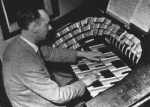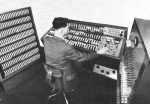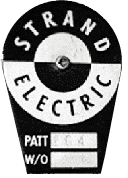
Larger installations are appropriately and economically controlled from electro-mechanical system CD or C consoles in which use is made of the inertia principle to provide 14 or 20 groups by means of an instantly adjustable memory preset action. The inertia in the electro-mechanical system derives from the fact that once the dimmer has been driven to its position through clutch and motor from a remote lever through a servo-system, the servo can be disconnected to leave the dimmer and the light stationery at the level it was last called. With an all-electric system the dimmer, whatever its form, has to be constantly activated from the control to hold its level. This ability in the inertia systems to be concerned only with the dimmers which have to change, has led Strand to a radically different approach to the large theatre or television installation. These Strand systems unlike those of other makers do not breed multitudes of preset dimmer levers.

For those who prefer an all-electric method for the large installation System CRD, using silicon controlled rectifiers, with straight 2,3 or 4 dimmer preset desks is available. Also the type of control described above for CD and C electro-mechanical controls is now available as system C/AE with all-electric silicon controlled rectifier dimmers. This facility has been achieved by Strand without the use of mechanical devices and represents a real breakthrough since, for the first time the unique memory action to select for change only of the best Strand systems is available without the requirement of an electro-mechanical dimmer bank.

There remains the question of complete memory or automatic plotting. In April, 1959, Strand Electric demonstrated publicly the first fully automatic lighting control in the world - Strand System KTV. In this instance, punched card is used to record all changes. On play-back not only is the lighting repeated exactly as when recorded but the switchboard controls automatically and instantly repeat their exact setup at the time of punching the card. Thus immediate modification to lighting is always possible, a facility which is invaluable during rehearsals and run throughs.

Experiments with our full sized System KTV console have nevertheless shown us that punched card is fundamentally unsuited to rehearsal and this even when, as in our case, the card sets up the control panel as well as the lighting. It is the rehearsal facilities which are important, not those for subsequent reproduction. In the theatre once the first night is over the operator is over the principle hurdle. In television every night is a first night in any case and no subsequent reproduction is required. Meantime experiment goes on and when the perfect switchboard memory appears Strand Electric will let you know.

Strand Electric have unique facilities for development of lighting controls due to their close contact with actual production in the theatre and in television. It is a strict rule that their engineer designers must approach these controls from the operators end. Too often with others, a purely engineering approach to the electric form and cost of the latest gimmick is allowed to distort the ultimate purpose of lighting controls which is to allow the operator immediate expression - painting with light.



